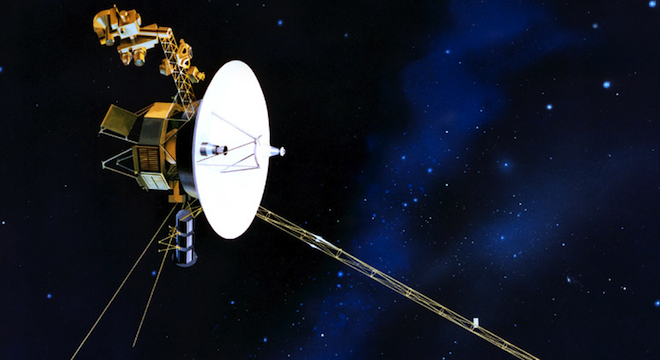NASA’s unmanned Voyager 1 spacecraft, launched in 1977, has become the first vessel in history to reach the edge of the solar system, NASA announced in mid-June.
It’s hard to overstate the milestone: At some point in the near future — it could be days or months, possibly, but not likely even a few years — Voyager is expected to break away from the bubble of particles emitted by the Sun encasing our solar system and enter the totally new, completely unexplored region of interstellar space, the black void separating us from the other star systems in our Milky Way Galaxy.
Voyager’s ability to travel through the solar system to where it is now, 11 billion miles from Earth, passing by and snapping what were then the best images of Jupiter and Saturn in the process, has been a “crowning achievement,” according to the project’s chief scientist, Ed Stone, a preeminent 76 year-old physicist at Caltech, in a telephone interview with TPM.
“We were hopeful that the spacecraft would reach interstellar space,” Stone told TPM. “It’s really set some records: The longest and furthest-flying spacecraft ever designed and built.”
Stone would know: He’s been the active project scientist for the Voyager program from its onset, leading the design and construction of the spacecraft and its sister Voyager 2 back in 1972, and taking charge of their journeys through the solar system. Voyager 2 is also still flying in good shape, although it is slightly behind Voyager 1 and thus won’t reach the solar system’s edge until after its sibling.
“We had no empirical basis for knowing how long the spacecraft would last and no way to predict how all the equipment would work, so most critical systems had backups, which we are running on in some cases,” Stone told TPM.
But Stone and his colleagues at NASA’s Jet Propulsion Laboratory (JPL) in Pasadena, California, began to get excited about the prospect of Voyager 1 leaving known space early this year, when its still-functioning instruments detected and transmitted back to Earth readings of increased galactic cosmic rays striking the spacecraft, rays that could only have come from outside the solar system.
Check out the following video of Voyager’s recent findings from NASA:
In fact, the level of the galactic cosmic rays has increased about 25 percent between 2009 and 2012, according to JPL, meaning that the spacecraft has entered the “heliosheath,” or the region where solar winds begin to collide with galactic cosmic rays.
“The galactic cosmic rays are trying to get in, but they’re having trouble due to the solar wind,” Stone told TPM.
Stone said that to imagine the phenomena Voyager is encountering right now, a person should go and turn on a faucet above a sink at relatively high pressure. Looking down into the sink, a person would see the stream of water striking the bottom of the sink and producing a thick ring right at the point that the stream strikes the basin. The ring terminates abruptly a few inches in diameter out from the stream. The ring, Stone told TPM, is exactly like the bubble of solar particles encasing the solar system, which is called the heliosphere.
“It’s very difficult to estimate the size of the bubble,” Stone noted, “We can’t be exactly sure where it ends. We don’t know what the pressure outside will be like.”
That’s why it may be months, or potentially even years, before Voyager actually breaches the barrier — known as heliopause — and enters interstellar space.
See a NASA illustration of the various regions Voyager is set to pass through below.

In order to be able to confirm the spacecraft has left the solar system, JPL needs to see two more readings change dramatically: The level of solar cosmic rays that Voyager detects coming from the Sun need to dramatically decrease, and the orientation of the magnetic field outside the spacecraft needs to change its direction from the east-west, the direction of the Sun’s rotation, to north-south, the speculated magnetic field of the nearby intergalactic region.
Interested members of the public can follow along and see Voyager’s distance from Earth in realtime on JPL’s Voyager website
When Voyager does cross over into the unknown, Stone hopes the spacecraft that he’s been in charge of for the past 40 years will be able to give us a clearer picture of the universe outside our solar system.
“We want to actually determine the [interstellar] wind which is outside,” Stone told TPM. “We have reasonably good models but we’ve often been surprised. We also need to take measurements and sample the cosmic rays outside that have been produced by supernovae five to ten to 15 million years ago.”
The Voyager spacecraft, nuclear-powered by plutonium-238 batteries, is expected to allow the spacecraft to keep functioning until 2020, when the JPL operators will have to begin switching off select instruments, until 2025, when it is likely that all instruments will have to be shutdown and the spacecraft will lose contact with Earth.
Still, even at that point, Voyager could prove to be an emissary: The two spacecraft are both carrying gold-plated records containing sounds of Earth — bird calls, thunder, music, greetings in 55 human languages — as well as electronic images, and engravings with instructions on how to play them using an included needle, for the benefit of any extraterrestrial intelligent life that may encounter them.
See what the records look like in the following NASA photo:

Stone said that although the records were still intact, he thought it was “highly unlikely” that they would ever be played.
“It’s very unlikely they’ll ever be found,” Stone said. “They were actually more of a message to us here on Earth that our technology had gotten to the point that we were capable of sending such a greeting.”






